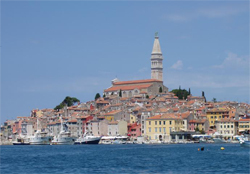 Rovinj is a striking image of coloured stone and Venetian houses gathered beneath the Baroque Cathedral of St. Euphemia, all rising abruptly out of the azure sea. The town was originally built on a small island and in the 18th century the channel was filled in. Jules Werne chose its dramatic setting as a background for some chapters of his novel "Mathias Sandorf".
Rovinj is a striking image of coloured stone and Venetian houses gathered beneath the Baroque Cathedral of St. Euphemia, all rising abruptly out of the azure sea. The town was originally built on a small island and in the 18th century the channel was filled in. Jules Werne chose its dramatic setting as a background for some chapters of his novel "Mathias Sandorf".
Once through the old city walls, you climb your way up through the narrow cobbled streets to the cathedral. Inside the church, St. Euphemia's corpse lies in the sarcophagus which, according to legend, disappeared from Constantinople around 800AD and miraculously washed up on the coast of Rovinj. From the top, the views of the old town and the islands scattered in front of Rovinj's coast are spectacular. Rovinj's waterfront is lined with cafes, seafood restaurants, bright boats at its moorings and floating markets selling sponges, shells and aquarelles. A few steps away are the fish and local produce market with all the required ingredients for good Istrian cooking - fresh seafood, organic vegetables, herbs, olives and fruit.
Rovinj is encircled with strings of islands and islets. Particularly beautiful are the islands of St. Catherine and St. Andrew in front of the town and the Red Island further out to sea. A Benedictine monastery was originally built on the Red Island, later expanded into a Franciscan monastery, then a castle, and finally a hotel.